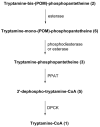Enzymatic and cellular study of a serotonin N-acetyltransferase phosphopantetheine-based prodrug
- PMID: 17258461
- PMCID: PMC1831523
- DOI: 10.1016/j.bmc.2006.12.016
Enzymatic and cellular study of a serotonin N-acetyltransferase phosphopantetheine-based prodrug
Abstract
Serotonin N-acetyltransferase (arylalkylamine N-acetyltransferase, AANAT) regulates the daily rhythm in the production of melatonin and is therefore an attractive target for pharmacologic modulation of the synthesis of this hormone. Previously prepared bisubstrate analogs show potent inhibition of AANAT but have unfavorable pharmacokinetic properties due to the presence of phosphate groups which prevents transfer across the plasma membrane. Here, we examine a bis-pivaloyloxymethylene (POM)-tryptamine-phosphopantetheine prodrug (2) and its biotransformations in vitro by homogenates and pineal cells. Compound 2 is an efficient porcine liver esterase substrate for POM cleavage in vitro although cyclization of the phosphate moiety is a potential side product. Tryptamine phosphopantetheine (3) is converted to tryptamine-coenzyme A (CoA) bisubstrate analog (1) by human phosphoribosyl pyrophosphate amidotransferase (PPAT) and dephosphocoenzyme A kinase (DPCK) in vitro. Compound 2 was found to inhibit melatonin production in rat pineal cell culture. It was also found that the POM groups are readily removed to generate 3; however, further processing to tryptamine-CoA (1) is much slower in pineal extracts or cell culture. Implications for CoA prodrug development based on the strategy used here are discussed.
Figures







Similar articles
-
Circadian dynamics of the cone-rod homeobox (CRX) transcription factor in the rat pineal gland and its role in regulation of arylalkylamine N-acetyltransferase (AANAT).Endocrinology. 2014 Aug;155(8):2966-75. doi: 10.1210/en.2014-1232. Epub 2014 May 30. Endocrinology. 2014. PMID: 24877634
-
Neural regulation of dark-induced abundance of arylalkylamine N-acetyltransferase (AANAT) and melatonin in the carp (Catla catla) pineal: an in vitro study.Chronobiol Int. 2011 Aug;28(7):572-85. doi: 10.3109/07420528.2011.590913. Epub 2011 Jul 21. Chronobiol Int. 2011. PMID: 21777116
-
Dynamics in enzymatic protein complexes offer a novel principle for the regulation of melatonin synthesis in the human pineal gland.J Pineal Res. 2011 Aug;51(1):145-55. doi: 10.1111/j.1600-079X.2011.00880.x. Epub 2011 Apr 26. J Pineal Res. 2011. PMID: 21517958
-
[Regulatory mechanism of melatonin synthesis in pineal gland: regulation of serotonin N-acetyltransferase activity].Seikagaku. 2005 May;77(5):411-5. Seikagaku. 2005. PMID: 15952330 Review. Japanese. No abstract available.
-
Gut melatonin: A potent candidate in the diversified journey of melatonin research.Gen Comp Endocrinol. 2021 Mar 1;303:113693. doi: 10.1016/j.ygcen.2020.113693. Epub 2020 Dec 10. Gen Comp Endocrinol. 2021. PMID: 33309697 Review.
Cited by
-
De novo discovery of serotonin N-acetyltransferase inhibitors.J Med Chem. 2007 Nov 1;50(22):5330-8. doi: 10.1021/jm0706463. Epub 2007 Oct 9. J Med Chem. 2007. PMID: 17924613 Free PMC article.
-
In vivo modification of native carrier protein domains.Chembiochem. 2009 Apr 17;10(6):1091-100. doi: 10.1002/cbic.200800838. Chembiochem. 2009. PMID: 19308927 Free PMC article.
-
A phosphorylated prodrug for the inhibition of Pin1.Bioorg Med Chem Lett. 2007 Dec 1;17(23):6615-8. doi: 10.1016/j.bmcl.2007.09.073. Epub 2007 Sep 26. Bioorg Med Chem Lett. 2007. PMID: 17935986 Free PMC article.
References
-
- Arendt J. Melatonin and the Mammalian Pineal Gland. Chapman & Hall; London: 1995.
-
- Maestromi GJ, Conti A, Pierpaoli W. Immunology. 1988;63:465. - PMC - PubMed
- Harlow HJ. J Pineal Res. 1987;4:147. - PubMed
- Lewy AJ, Sack RL, Miller LS, Hoban TA. Science. 1987;235:352. - PubMed
- Iguchi H, Kato K, Ibayashi H. J Clin Endocrin Metab. 1982;55:27. - PubMed
- Akerstedtn. 219;79(4)
- Cohen M, Chabner B. Lancet. 1978;ii:814. - PubMed
-
- Klein DC, Weller JL. Science. 1970;169:1093. - PubMed
- Coon SL, Roseboom PH, Baler R, Weller JL, Namboodiri MAA, Koonin EV, Klein DC. Science. 1995;270:1681. - PubMed
- Borijin J, Wang MM, Snyder SH. Nature. 1995;378:783. - PubMed
- Klein DC, Roseboom PH, Coon SL. Trends Endocrinol Metab. 1996;7:106. - PubMed
- Klein DC, Coon SL, Roseboom PH, Weller JL, Bernard M, Gastel JA, Zatz M, Iuvone PM, Rodriquez IR, Begay V, Falcon J, Cahil GM, Cassone VM, Baler R. Recent Prog Hormone Res. 1997;52:307. - PubMed
-
- Boutin JA, Audinot V, Ferry G, Delagrange P. Trends Pharmacol Sci. 2005;26:412. - PubMed
- Ferry G, Ubeaud G, Mozo J, Pean C, Hennig P, Rodriguez M, Scoul C, Bonnaud A, Nosjean O, Galizzi JP, Delagrange P, Renard P, Volland JP, Yous S, Lesieur D, Boutin JA. Eur J Biochem. 2004;271:418. - PubMed
- Zheng W, Cole PA. Bioorg Chem. 2003;31:398. - PubMed
- Zheng W, Cole PA. Curr Med Chem. 2002;9:1187. - PubMed
- Beaurain N, Mesangeau C, Chavatte P, Ferry G, Audinot V, Boutin JA, Delagrange P, Bennejean C, Yous S. J Enzyme Inhib Med Chem. 2002;17:409. - PubMed
- Ferry G, Loynel A, Kucharczyk N, Bertin S, Rodriguez M, Delagrange P, Galizzi JP, Jacoby E, Volland JP, Lesieur D, Renard P, Canet E, Fauchere JL, Boutin JA. J Biol Chem. 2000;275:8794. - PubMed
- Kim CM, Cole PA. J Med Chem. 2001;44:2479. - PubMed
- Khalil EM, De Angelis J, Ishii M, Cole PA. Proc Natl Acad Sci USA. 1999;96:12418. - PMC - PubMed
- Khalil EM, Cole PA. J Am Chem Soc. 1998;120:6195.
- Robisaw JD, Neely JR. Am J Physiol. 1985;248:E1. - PubMed
- Lewczuk B, Zheng W, Prusik M, Cole PA, Przybylska-Gornowicz B. Neuro Endocrinol Lett. 2005;26:581. - PubMed
-
- Vetting MW, S de Carvalho LP, Yu M, Hegde SS, Magnet S, Roderick SL, Blanchard JS. Arch Biochem Biophys. 2005;433:212. - PubMed
- Marmorstein R. J Mol Biol. 2001;311:433. - PubMed
- Dyda F, Klein DC, Hickman AB. Annu Rev Biophys Biomol Struc. 2000;29:81. - PMC - PubMed
- Newald AF, Landsman D. Trends Biochem Sci. 1997;22:154. - PubMed
Publication types
MeSH terms
Substances
Grants and funding
LinkOut - more resources
Full Text Sources
Other Literature Sources
Miscellaneous

